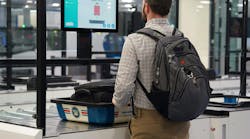Details continue to emerge about the gunman who opened fire in Los Angeles International Airport (LAX) last fall, killing a security screener and wounding three others. One of the more shocking details is the fact that two armed officers assigned to the area left for breaks right before the shooting without informing a dispatcher as required. Because of their actions, police did not arrive until after an airline contractor reportedly called a police dispatcher who alerted officers over the radio.
The actions of the armed guards, the vulnerability of airport security systems, the potential arming of TSA agents, and lone wolf terrorists are all things being weighed in by the media in the aftermath of this horrible tragedy.
Airport Business recently caught up with Jeffrey Simon, an internationally renowned terrorism expert and author of “Lone Wolf Terrorism: Understanding the Growing Threat,” for his insight on lone wolf shooters, airport security, and what needs to happen now.
The LAX shooter has been described as a lone wolf terrorist. Can you elaborate on what a lone wolf terrorist is?
A lone wolf terrorist is an individual who is working alone, or sometimes with another person, but is not part of an organized terrorist cell. Because they are not part of a group, they are free to think up a violent scenario then act upon it, that’s what makes them so creative—and dangerous. Some examples of lone wolf terrorists are Nidal Hasan, the shooter at Fort Hood, and the Tsarnaev brothers, who did the Boston bombing. These individuals did not have any connection with extremist groups.
What are their reasons for the actions they take?
Normally the definition of terrorism is a violent act committed by two individuals for a political purpose or political motivation. But in the case of the lone wolf, I don’t believe you always have political or religious motivation. We have seen lone wolves who have this motivation, but sometimes just a criminal motivation can still qualify as a lone wolf attack.
How much of a threat are lone wolf terrorists versus large-scale terrorist groups?
I see the lone wolf as a very serious threat because the lone wolf is not accountable to anybody but himself. In groups such as al-Qaeda, you have a group decision-making process going on. Somebody may come up with an idea and it may be shot down. But a lone wolf, if they feel they have the capability to do something, will just do it. Lone wolves think very creatively and come up with ideas that someone else may not have thought of.
Why is the phenomenon growing?
Part of the reason it is growing is that folks become radicalized by reading terrorist web pages or by engaging in anonymous chat rooms. They become empowered by the information they get and believe they can perpetrate various kinds of attacks. In the case of the LAX attacks, there is some debate as to whether you can call it a politically motivated terrorist or an emotionally disturbed individual. He did have a gripe against the TSA and he targeted TSA agents. Based on that, I would call it a lone wolf terrorist attack.
Airports have long prepared for larger terrorist acts, but are there security issues that remain as they pertain to the lone wolf?
Part of the problem is that lone wolves, because they are not working as a group, can blend in with others and there may be no way to distinguish between them and nonviolent passengers. What the LAX shooting demonstrated is the worst nightmare of all security planners-- a violent attack, whether a bombing or a shooting, in unsecured areas. Some have suggested that there needs to be security checkpoints as people enter airport lobbies, but in airports, such as Los Angeles, that’s really impractical. You would create tremendous traffic jams going up to the airport’s entry point and would create vulnerable areas as people wait to check in. Pushing out the security still leaves vulnerable areas for passengers.
Obviously CCTV cameras are very important, but then again you have to be able to determine whether or not somebody is walking through the lobby with violent intent. How do you do that? There is research being conducted in order to automate CCTV cameras with smart sensors that are able to pick up unusual activity and can determine when something is suspicious … maybe even using biometrics, to perform gait analysis. If somebody is carrying a bomb, do they walk differently? There is a lot of research being done in that area.
Today, in addition to adding improved CCTV cameras and sensors, there should be a greater law enforcement and security presence. Nobody wants to see too many police in an airport, but people also feel more secure when they do. In the LAX attack, the gunman, Paul Anthony Ciancia, was able to walk in without anyone noticing anything, walk straight up to the TSA agent and start shooting. That is something that needs to be addressed.
Another thing that needs to be addressed because of this incident is the whole question of response once an active shooting incident occurs. What they found in LAX and in other cases is paramedics do not walk into the hot zones, which makes sense because you wouldn’t want them to get shot, but they need to be able to get paramedics closer to treat the wounded. At LAX, the TSA agent was wounded but they couldn’t get to him for awhile.
Some have called for the arming of TSA agents. Do you feel this is the answer?
In this incident, the TSA did lose one of their own. However, it’s always problematic when you introduce more firearms to security personnel at the airport. I haven’t seen any studies yet as to whether or not that would work. A better solution might be adding uniformed police, and even if its undercover agents walking around, rather than arming TSA agents. People are living in the post 9/11 environment, so it’s not surprising to see uniformed police living in vulnerable target areas. But in the case of Ciancia, if he had walked in and there had been armed police milling around, would he have been deterred from the attack? Would police have gotten suspicious? Nobody really knows how many security personnel you need patrolling an area, but we are living in a society where individuals with hostile intent are able to roam freely in these vulnerable spots, so the more presence of police there is to deter them, the more it would help.
What is the takeaway from this tragedy?
This shooting demonstrated the vulnerability of the lobby areas, which has long been the fear of security planners. It is yet another example of lone wolves have historically shown us the vulnerability of our security. For example, in 1956, the first mid-air plane bombing in U.S. history was done by a lone wolf criminal named John Gilbert Graham. He placed sticks of dynamite in his mother’s luggage. The plane blew up, killing her and scores of other people. He was trying to collect an insurance policy on her life. It caused all this anxiety about air travel and it was the first time questions were raised about airport security. They eventually realized they were going to have to start creating systems that can deter criminals or terrorists who have bombs. The terrorists were ahead of the technology at that point. We weren’t ready yet for those kinds of incidents. The first major plane hijacking in the United States was done by a lone wolf too. Lone wolves have proven very dangerous for airport security.
What advice would you give to airports?
Whether it’s the lone wolf or a terrorist group, airport security is a never-ending technological battle. You need to always try to stay one step ahead of the terrorist. As much as you improve your security, there are terrorists trying to think up ways to overcome that. Also, we can’t expect to be 100 percent successful in preventing terrorist attacks at airports or elsewhere but our goal should always be to both reduce uncertainty and reduce the risk to passengers and airport workers by trying to prevent these attacks. Unless you’re going to have a fortress America, unfortunately, there will always be a risk for terrorist attacks, including those at airports.


